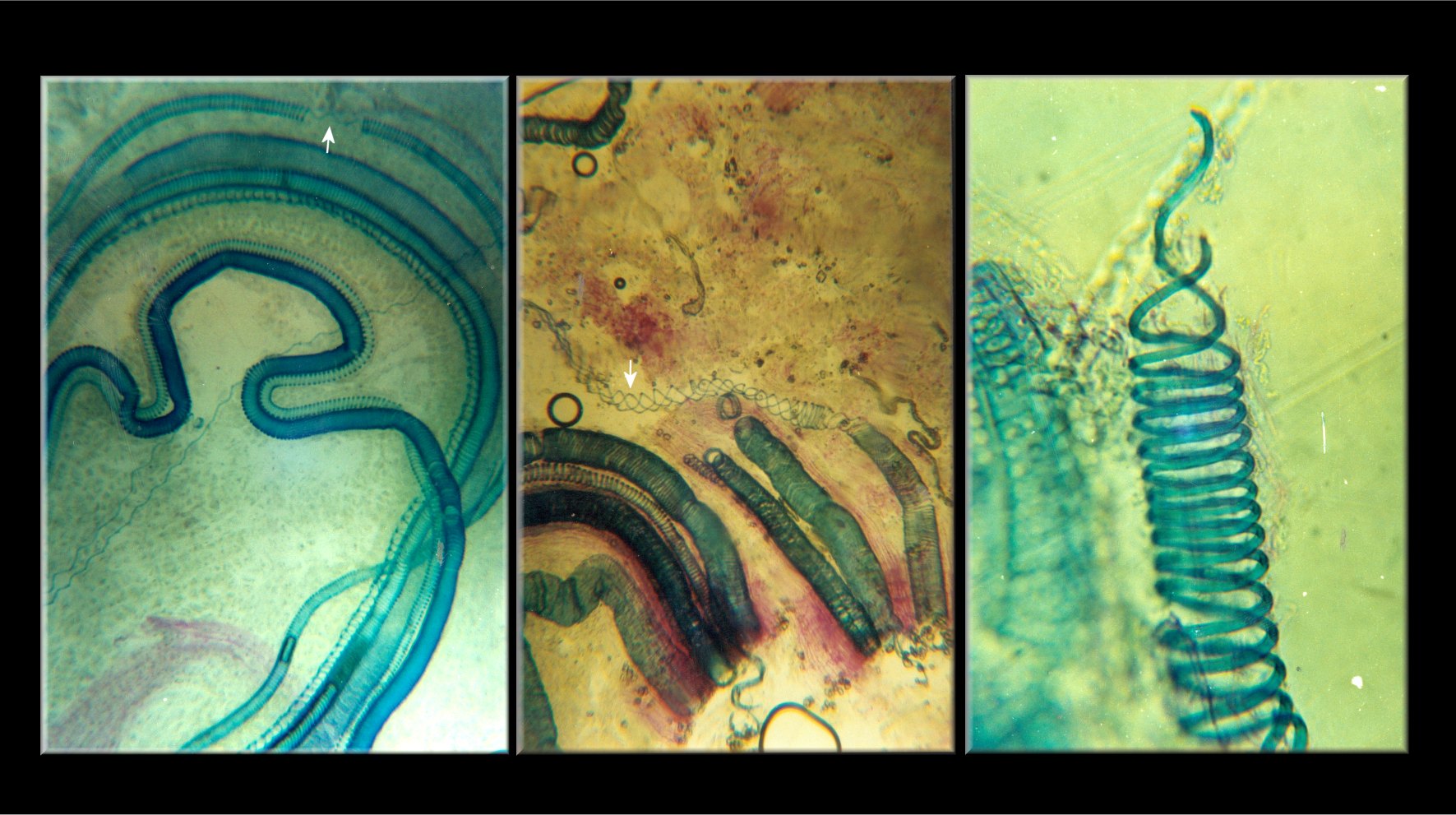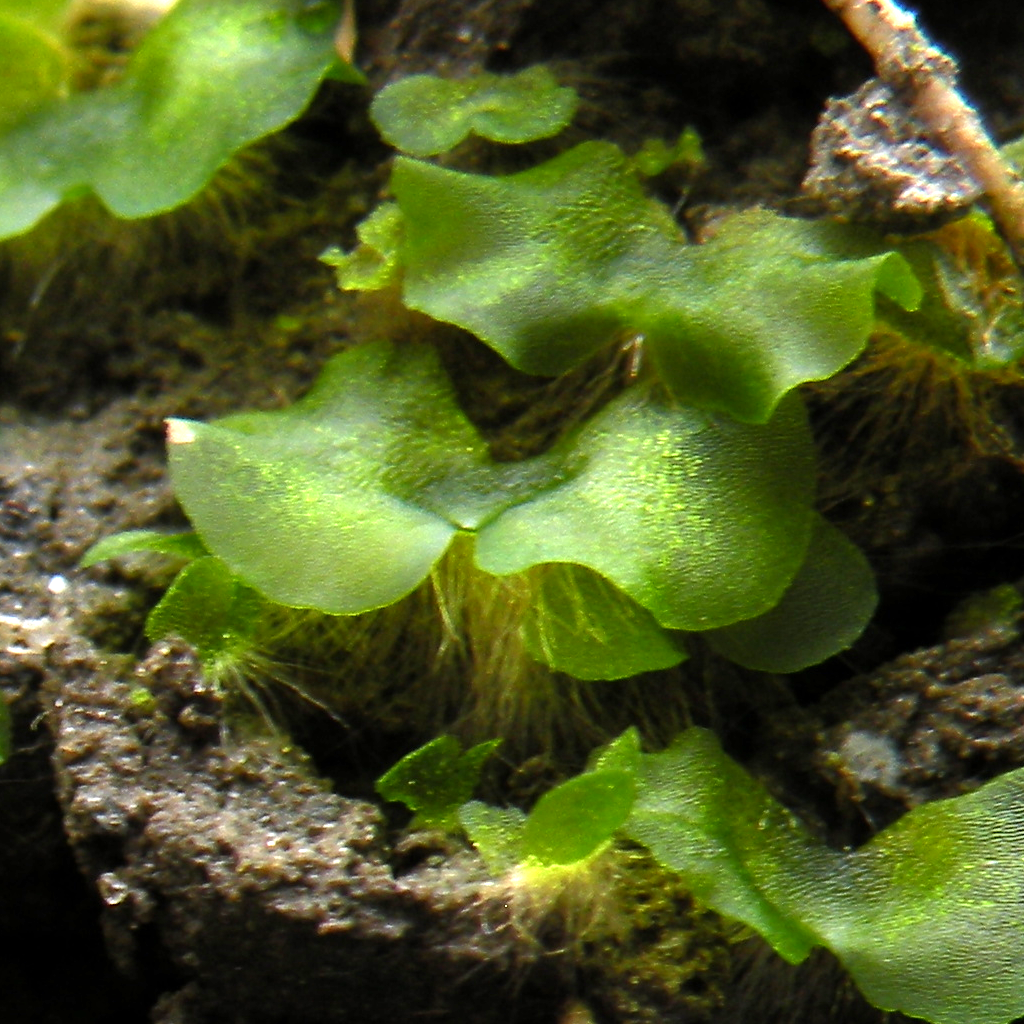|
Hsuaceae
''Hsua'' is a genus of extinct vascular plants, known from the Devonian. The name of the genus honours the Chinese palaeobotanist, Jen Hsü. Features The main stems (axes) of ''Hsua robusta'' are about an inch thick, with circinate, pseudo-monopodial side branches emerging from the sides. The small side branches emerge immediately above a dichotomous branching point of the main axis. The lateral branches are in a plane (planar). In the centre of the axes is a protostele with an elliptical cross-section. The protoxylem was probably inside the xylem, maturing from the inside out. The tracheids have annular secondary wall thickening. Round- to kidney-shaped sporangia lie on dichotomous branches at the end of the lateral branches, and open with symmetrical valves. The trilete spores are 18 to 36 µm in size. The gametophyte is unknown. In ''Hsua deflexa'', the main axis was creeping with the lateral axes at right angles from it. The axes had thorny spikes. Preservation ... [...More Info...] [...Related Items...] OR: [Wikipedia] [Google] [Baidu] |
Sawdoniales
The Sawdoniales are an order or plesion of extinct zosterophylls. The zosterophylls were among the first vascular plants in the fossil record, and share an ancestor with the living lycophytes. The group has been divided up in various ways. In their major cladistic Cladistics (; ) is an approach to biological classification in which organisms are categorized in groups (" clades") based on hypotheses of most recent common ancestry. The evidence for hypothesized relationships is typically shared derived ch ... study of early land plants, Kenrick and Crane placed most of the zosterophylls in the Sawdoniales (which they treated as a plesion). Like other zosterophylls, members of the Sawdoniales bore lateral, reniform sporangia. They branched dichotomously, and grew at the ends by unrolling ( circinate vernation). Some had smooth stems, others were covered in small spines; fungal bodies have been reported in some spines. Taxonomy In 1997, Kenrick and Crane placed most of the ... [...More Info...] [...Related Items...] OR: [Wikipedia] [Google] [Baidu] |
Vascular Plant
Vascular plants (), also called tracheophytes () or collectively Tracheophyta (), form a large group of land plants ( accepted known species) that have lignified tissues (the xylem) for conducting water and minerals throughout the plant. They also have a specialized non-lignified tissue (the phloem) to conduct products of photosynthesis. Vascular plants include the clubmosses, horsetails, ferns, gymnosperms (including conifers), and angiosperms (flowering plants). Scientific names for the group include Tracheophyta, Tracheobionta and Equisetopsida ''sensu lato''. Some early land plants (the rhyniophytes) had less developed vascular tissue; the term eutracheophyte has been used for all other vascular plants, including all living ones. Historically, vascular plants were known as "higher plants", as it was believed that they were further evolved than other plants due to being more complex organisms. However, this is an antiquated remnant of the obsolete scala naturae, an ... [...More Info...] [...Related Items...] OR: [Wikipedia] [Google] [Baidu] |
Species
In biology, a species is the basic unit of Taxonomy (biology), classification and a taxonomic rank of an organism, as well as a unit of biodiversity. A species is often defined as the largest group of organisms in which any two individuals of the appropriate sexes or mating types can reproduction, produce Fertility, fertile offspring, typically by sexual reproduction. Other ways of defining species include their karyotype, DNA sequence, morphology (biology), morphology, behaviour or ecological niche. In addition, paleontologists use the concept of the chronospecies since fossil reproduction cannot be examined. The most recent rigorous estimate for the total number of species of eukaryotes is between 8 and 8.7 million. However, only about 14% of these had been described by 2011. All species (except viruses) are given a binomial nomenclature, two-part name, a "binomial". The first part of a binomial is the genus to which the species belongs. The second part is called the specifi ... [...More Info...] [...Related Items...] OR: [Wikipedia] [Google] [Baidu] |
Gametophyte
A gametophyte () is one of the two alternation of generations, alternating multicellular organism, multicellular phases in the life cycles of plants and algae. It is a haploid multicellular organism that develops from a haploid spore that has one set of chromosomes. The gametophyte is the Sexual reproduction of plants, sexual phase in the life cycle of plants and algae. It develops sex organs that produce gametes, haploid sex cells that participate in fertilization to form a diploid zygote which has a double set of chromosomes. Cell division of the zygote results in a new diploid multicellular organism, the second stage in the life cycle known as the sporophyte. The sporophyte can produce haploid spores by meiosis that on germination produce a new generation of gametophytes. Algae In some multicellular green algae (''Ulva lactuca'' is one example), red algae and brown algae, sporophytes and gametophytes may be externally indistinguishable (isomorphic). In ''Ulva (genus), Ulv ... [...More Info...] [...Related Items...] OR: [Wikipedia] [Google] [Baidu] |
Cladistic Analysis
Cladistics (; ) is an approach to biological classification in which organisms are categorized in groups (" clades") based on hypotheses of most recent common ancestry. The evidence for hypothesized relationships is typically shared derived characteristics (synapomorphies'')'' that are not present in more distant groups and ancestors. However, from an empirical perspective, common ancestors are inferences based on a cladistic hypothesis of relationships of taxa whose character states can be observed. Theoretically, a last common ancestor and all its descendants constitute a (minimal) clade. Importantly, all descendants stay in their overarching ancestral clade. For example, if the terms ''worms'' or ''fishes'' were used within a ''strict'' cladistic framework, these terms would include humans. Many of these terms are normally used paraphyletically, outside of cladistics, e.g. as a ' grade', which are fruitless to precisely delineate, especially when including extinct species. ... [...More Info...] [...Related Items...] OR: [Wikipedia] [Google] [Baidu] |
Rhyniopsida
The rhyniophytes are a group of extinct early vascular plants that are considered to be similar to the genus '' Rhynia'', found in the Early Devonian (around ). Sources vary in the name and rank used for this group, some treating it as the class Rhyniopsida, others as the subdivision Rhyniophytina or the division Rhyniophyta. The first definition of the group, under the name Rhyniophytina, was by Banks, since when there have been many redefinitions, including by Banks himself. "As a result, the Rhyniophytina have slowly dissolved into a heterogeneous collection of plants ... the group contains only one species on which all authors agree: the type species ''Rhynia gwynne-vaughanii''". When defined very broadly, the group consists of plants with dichotomously branched, naked aerial axes ("stems") with terminal spore-bearing structures (sporangia). The rhyniophytes are considered to be stem group tracheophytes (vascular plants). Definitions The group was described as a subdivis ... [...More Info...] [...Related Items...] OR: [Wikipedia] [Google] [Baidu] |
Emsian
The Emsian is one of three faunal stages in the Early Devonian Epoch. It lasted from 407.6 ± 2.6 million years ago to 393.3 ± 1.2 million years ago. It was preceded by the Pragian Stage and followed by the Eifelian Stage. It is named after the Ems river in Germany. The GSSP is located in the Zinzil'ban Gorge in the Kitab State Geological Reserve of Uzbekistan, above the contact with the Madmon Formation. In North America the Emsian Stage is represented by Sawkill or Sawkillian time. Biological events During this period, earliest known agoniatitid ammonoid fossils began appearing within this stage after first appearing in previous stage and began to evolutionarily radiate within this stage, in which a new ammonoid order Goniatitida rises in the end of Zlichovian stage (Siberian representation; corresponds to early Eifelian and after the end of Early Devonian, before 391.9 mya Mya may refer to: Brands and product names * Mya (program), an intelligent personal as ... [...More Info...] [...Related Items...] OR: [Wikipedia] [Google] [Baidu] |
Pragian
The Pragian is one of three faunal stages in the Early Devonian Epoch. It lasted from 410.8 ± 2.8 million years ago to 407.6 ± 2.8 million years ago. It was preceded by the Lochkovian Stage and followed by the Emsian Stage. The most important Lagerstätte of the Pragian is Rhynie chert in Scotland. It is named after the city of Prague. The GSSP is located within the Prague Formation at Velká Chuchle, Prague. In North America the Pragian Stage is represented by Siegenian or Deerparkian time. Pragian life The first ammonoids (order Agoniatitida) appeared in later parts of this stage (at the lower boundary of the Zlichovian stage as it was known in Siberian representations). They were descended from bactritoid nautiloid Nautiloids are a group of marine cephalopods ( Mollusca) which originated in the Late Cambrian and are represented today by the living ''Nautilus'' and '' Allonautilus''. Fossil nautiloids are diverse and speciose, with over 2,500 recorded speci ... an ... [...More Info...] [...Related Items...] OR: [Wikipedia] [Google] [Baidu] |
Early Devonian
The Early Devonian is the first of three epochs comprising the Devonian period, corresponding to the Lower Devonian series. It lasted from and began with the Lochkovian Stage , which was followed by the Pragian from and then by the Emsian, which lasted until the Middle Devonian began, . During this time, the first ammonoids appeared, descending from bactritoid nautiloids. Ammonoids during this time period were simple and differed little from their nautiloid counterparts. These ammonoids belong to the order Agoniatitida, which in later epochs evolved to new ammonoid orders, for example Goniatitida and Clymeniida. This class of cephalopod molluscs would dominate the marine fauna until the beginning of the Mesozoic The Mesozoic Era ( ), also called the Age of Reptiles, the Age of Conifers, and colloquially as the Age of the Dinosaurs is the second-to-last era of Earth's geological history, lasting from about , comprising the Triassic, Jurassic and Cretaceo ... Era. Reference ... [...More Info...] [...Related Items...] OR: [Wikipedia] [Google] [Baidu] |
China
China, officially the People's Republic of China (PRC), is a country in East Asia. It is the world's List of countries and dependencies by population, most populous country, with a Population of China, population exceeding 1.4 billion, slightly ahead of India. China spans the equivalent of five time zones and Borders of China, borders fourteen countries by land, the List of countries and territories by land borders, most of any country in the world, tied with Russia. Covering an area of approximately , it is the world's third List of countries and dependencies by area, largest country by total land area. The country consists of 22 provinces of China, provinces, five autonomous regions of China, autonomous regions, four direct-administered municipalities of China, municipalities, and two special administrative regions of China, Special Administrative Regions (Hong Kong and Macau). The national capital is Beijing, and the List of cities in China by population, most populous cit ... [...More Info...] [...Related Items...] OR: [Wikipedia] [Google] [Baidu] |
Yunnan
Yunnan , () is a landlocked province in the southwest of the People's Republic of China. The province spans approximately and has a population of 48.3 million (as of 2018). The capital of the province is Kunming. The province borders the Chinese provinces of Guizhou, Sichuan, autonomous regions of Guangxi, and Tibet as well as Southeast Asian countries: Vietnam, Laos, and Myanmar. Yunnan is China's fourth least developed province based on disposable income per capita in 2014. Yunnan is situated in a mountainous area, with high elevations in the northwest and low elevations in the southeast. Most of the population lives in the eastern part of the province. In the west, the altitude can vary from the mountain peaks to river valleys by as much as . Yunnan is rich in natural resources and has the largest diversity of plant life in China. Of the approximately 30,000 species of higher plants in China, Yunnan has perhaps 17,000 or more. Yunnan's reserves of aluminium, lead, ... [...More Info...] [...Related Items...] OR: [Wikipedia] [Google] [Baidu] |





